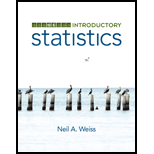
Exercises 7.11–7.23 are intended solely to provide concrete illustrations of the sampling distribution of the sample
7.22 America’s Richest. Repeat parts (b)–(e) of Exercise 7.17 for samples of size 6. What is the relationship between the only possible sample here and the population?
7.17 America’s Richest. Each year, Forbes magazine publishes a list of the richest people in the United States. As of September 16, 2013, the six richest Americans and their wealth (to the nearest billion dollars) are as shown in the following table. Consider these six people a population of interest.
| Person | Wealth ($ billions) |
| Bill Gates (G) | 72 |
| Warren Buffett (B) | 59 |
| Larry Ellison (E) | 41 |
| Charles Koch (C) | 36 |
| David Koch (D) | 36 |
| Christy Walton (W) | 35 |
- a. Calculate the mean wealth, μ, of the six people.
- b. For samples of size 2, construct a table similar to Table 7.2 on page 310. (There are 15 possible samples of size 2.)
- c. Draw a dotplot for the sampling distribution of the sample mean for samples of size 2.
- d. For a random
sample of size 2, what is the chance that the sample mean will equal the population mean?
For a random sample of size 2, determine the
Want to see the full answer?
Check out a sample textbook solution
Chapter 7 Solutions
Introductory Statistics (10th Edition)
Additional Math Textbook Solutions
Elementary Algebra For College Students (10th Edition)
Finite Mathematics for Business, Economics, Life Sciences and Social Sciences
APPLIED STAT.IN BUS.+ECONOMICS
College Algebra Essentials (5th Edition)
Graphical Approach To College Algebra
Elementary Statistics ( 3rd International Edition ) Isbn:9781260092561
- Harvard University California Institute of Technology Massachusetts Institute of Technology Stanford University Princeton University University of Cambridge University of Oxford University of California, Berkeley Imperial College London Yale University University of California, Los Angeles University of Chicago Johns Hopkins University Cornell University ETH Zurich University of Michigan University of Toronto Columbia University University of Pennsylvania Carnegie Mellon University University of Hong Kong University College London University of Washington Duke University Northwestern University University of Tokyo Georgia Institute of Technology Pohang University of Science and Technology University of California, Santa Barbara University of British Columbia University of North Carolina at Chapel Hill University of California, San Diego University of Illinois at Urbana-Champaign National University of Singapore McGill…arrow_forwardName Harvard University California Institute of Technology Massachusetts Institute of Technology Stanford University Princeton University University of Cambridge University of Oxford University of California, Berkeley Imperial College London Yale University University of California, Los Angeles University of Chicago Johns Hopkins University Cornell University ETH Zurich University of Michigan University of Toronto Columbia University University of Pennsylvania Carnegie Mellon University University of Hong Kong University College London University of Washington Duke University Northwestern University University of Tokyo Georgia Institute of Technology Pohang University of Science and Technology University of California, Santa Barbara University of British Columbia University of North Carolina at Chapel Hill University of California, San Diego University of Illinois at Urbana-Champaign National University of Singapore…arrow_forwardA company found that the daily sales revenue of its flagship product follows a normal distribution with a mean of $4500 and a standard deviation of $450. The company defines a "high-sales day" that is, any day with sales exceeding $4800. please provide a step by step on how to get the answers in excel Q: What percentage of days can the company expect to have "high-sales days" or sales greater than $4800? Q: What is the sales revenue threshold for the bottom 10% of days? (please note that 10% refers to the probability/area under bell curve towards the lower tail of bell curve) Provide answers in the yellow cellsarrow_forward
- Find the critical value for a left-tailed test using the F distribution with a 0.025, degrees of freedom in the numerator=12, and degrees of freedom in the denominator = 50. A portion of the table of critical values of the F-distribution is provided. Click the icon to view the partial table of critical values of the F-distribution. What is the critical value? (Round to two decimal places as needed.)arrow_forwardA retail store manager claims that the average daily sales of the store are $1,500. You aim to test whether the actual average daily sales differ significantly from this claimed value. You can provide your answer by inserting a text box and the answer must include: Null hypothesis, Alternative hypothesis, Show answer (output table/summary table), and Conclusion based on the P value. Showing the calculation is a must. If calculation is missing,so please provide a step by step on the answers Numerical answers in the yellow cellsarrow_forwardShow all workarrow_forward
 Glencoe Algebra 1, Student Edition, 9780079039897...AlgebraISBN:9780079039897Author:CarterPublisher:McGraw Hill
Glencoe Algebra 1, Student Edition, 9780079039897...AlgebraISBN:9780079039897Author:CarterPublisher:McGraw Hill Holt Mcdougal Larson Pre-algebra: Student Edition...AlgebraISBN:9780547587776Author:HOLT MCDOUGALPublisher:HOLT MCDOUGAL
Holt Mcdougal Larson Pre-algebra: Student Edition...AlgebraISBN:9780547587776Author:HOLT MCDOUGALPublisher:HOLT MCDOUGAL

